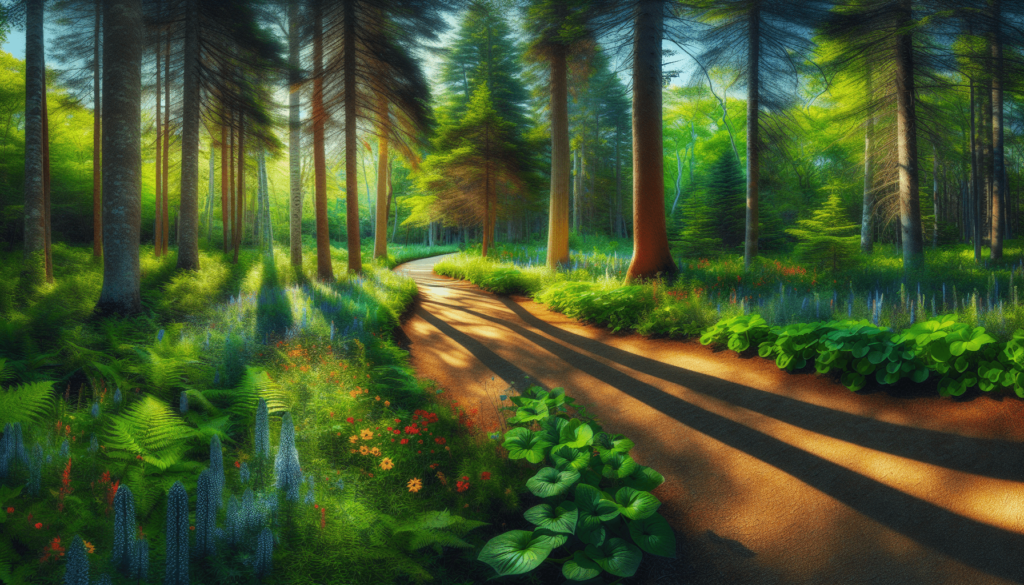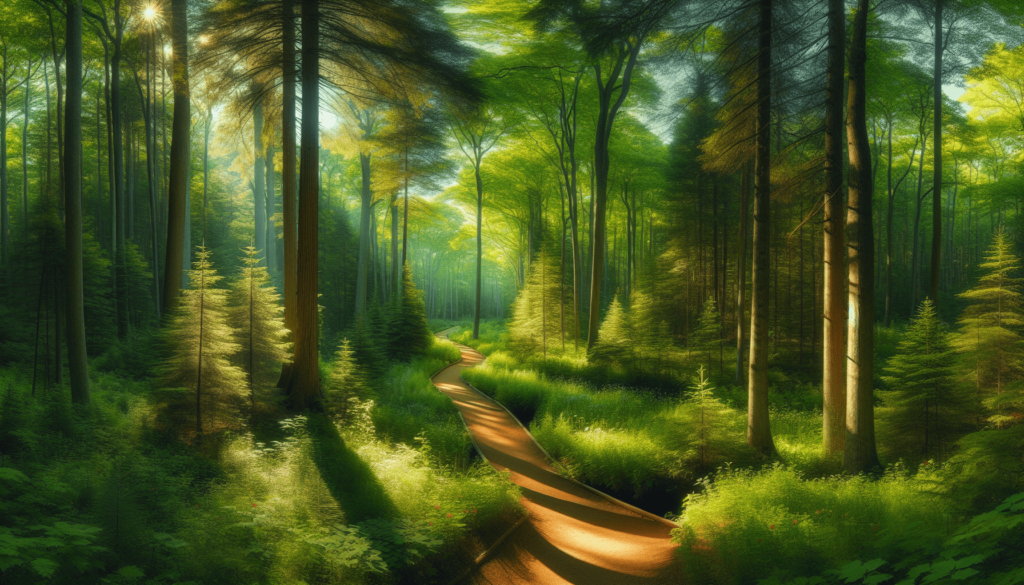Have you ever dreamed of wandering through a lush, vibrant forest, inhaling the fresh scent of pine, and listening to the serene sounds of nature? If that sounds appealing, then the Manistee National Forest, with its extensive trail system, might be just the place for you.
Overview of Manistee National Forest
Manistee National Forest, located in Michigan, spans over 500,000 acres of breathtaking landscapes that showcase the Beauty of the Great Lakes region. It’s a paradise for outdoor enthusiasts, offering a variety of recreational activities fueled by pristine natural surroundings. The forest is nestled between Lake Michigan and the Manistee River, providing a scenic backdrop that you won’t soon forget.
History
The history of Manistee National Forest is rich and reflective of the area’s natural transformation. The land was once home to Native American tribes, including the Ottawa and Chippewa nations. Later, it became a hub for logging in the late 19th and early 20th centuries, drastically changing the landscape. After years of deforestation, efforts for reforestation began, leading to the establishment of the national forest in 1936. Today’s forest showcases a mix of pine, hardwoods, and unique ecological features that tell the story of resilience.
Location and Access
Finding your way to the Manistee National Forest is straightforward. It stretches across several counties, including Manistee, Lake, Osceola, and Wexford. Major access points include:
| Access Point | Location | Main Features |
|---|---|---|
| Manistee Visitor Center | Manistee, MI | Trails, maps, and information |
| Wellston | Near US-31 | Great for camping and hiking access |
| Baldwin | MI-37 junction | Excellent entry for ATV trails |
You can access the forest off various highways, and notable roads lead you deep into the heart of the woodland experience.
Trail System
The Manistee National Forest features an extensive trail system that caters to various activities, including hiking, biking, equestrian rides, and snowmobiling. These trails range in difficulty from easy, family-friendly pathways to challenging routes for seasoned adventurers.
Types of Trails
Hiking Trails
Hiking in the Manistee National Forest is a remarkable way to appreciate the stunning landscapes and diverse ecosystems. The following trails are popular among hikers:
| Trail Name | Distance | Difficulty | Highlights |
|---|---|---|---|
| North Country Trail | 1,200 miles (total length) | Varies | Scenic views, wildlife, remote areas |
| Silver Lake Loop | 3 miles | Easy | Gorgeous lake views, family-friendly |
| Manistee River Trail | 20.1 miles | Moderate | Explore the riverbank, great fishing |
Each of these trails provides an opportunity to immerse yourself in nature. The North Country Trail, which runs through the forest, is part of a larger network connecting various states. This trail is perfect if you’re looking for a long-distance adventure.
Biking Trails
For biking enthusiasts, the Manistee National Forest provides ample trails to experience on two wheels. Here are a few noteworthy cycling paths:
| Trail Name | Distance | Difficulty | Features |
|---|---|---|---|
| 3 Mile Lake Trail | 3 miles | Easy | Short and family-friendly, ideal for beginners |
| Big Manistee River Trail | 14.5 miles | Moderate | A mix of terrain, scenic river views |
| Pine Ridge Trail | 6 miles | Moderate | Rolling hills and dense pine forests |
The various biking trails allow you to enjoy the refreshing breeze as you ride through shaded woodlands and alongside sparkling lakes.
Equestrian Trails
If you ride horses, you’ll be happy to know that there are designated equestrian trails within the Manistee National Forest. Here are a couple of popular options:
| Trail Name | Distance | Difficulty | Notable Features |
|---|---|---|---|
| Sable River Equestrian Trail | 9 miles | Moderate | Scenic views along the river |
| Big M State Forest Area Equestrian Trails | Varied | Varies | A network of diverse trails |
These trails often pass through the most serene areas of the forest, allowing horse riders to experience the beauty of nature in a unique way.
Tips for Trail Users
- Stay Hydrated: Carry plenty of water with you, especially on longer trails.
- Dress Appropriately: Wear weather-appropriate clothing and sturdy footwear.
- Pack Snacks: Bring along energy-boosting snacks to keep you fueled during your adventures.
- Follow Trail Etiquette: Yield the trail to those on foot if you’re biking and keep your noise levels low to respect wildlife.
- Leave No Trace: Respect the environment by cleaning up after yourself and sticking to marked trails.

Wildlife Watching
The rich biodiversity of Manistee National Forest makes it an exciting destination for wildlife enthusiasts. You can spot various animals as you traverse the trails. Here are some common residents you might encounter:
- White-tailed Deer: Commonly seen foraging in meadows.
- Bald Eagles: Majestic birds of prey that often soar above the forest.
- Black Bears: While they tend to avoid humans, you might catch a glimpse in the distance.
- Foxes and Coyotes: Often heard at dawn and dusk, these creatures add an air of wilderness to the forest.
Taking the time to observe wildlife can be a rewarding addition to your forest experience. Keep your distance and do not feed the animals to ensure their safety and yours.
Camping Opportunities
If you’re thinking of extending your time in the Manistee National Forest, camping is a fantastic choice. The forest offers a range of campgrounds to suit different preferences, from developed sites with amenities to primitive sites for a more rugged experience.
Popular Campgrounds
| Campground Name | Amenities | Reservation Status |
|---|---|---|
| Manistee River Campground | Restrooms, fire pits, picnic areas | First-come, first-served |
| Nordhouse Dunes Campground | Scenic dunes, lake access | Reservation required |
| Big M Campground | Vault toilets, nearby trails | First-come, first-served |
Each campground has unique features. For instance, Nordhouse Dunes offers breathtaking views of Lake Michigan and is known for its beautiful sandy beaches.
Campfire Guidelines
When camping, it’s essential to follow campfire regulations to ensure the safety of the forest. Here are some basic guidelines:
- Always check for fire restrictions before starting a campfire.
- Use existing fire rings where available.
- Keep fires small and manageable.
- Fully extinguish your fire before leaving the campsite.
Adhering to these guidelines helps preserve the environment and ensures a safe experience for everyone.

Seasonal Activities
Manistee National Forest offers something different in every season, so let’s break down what you can expect throughout the year.
Spring
As the snow melts and life returns, spring is a beautiful time in the forest. Wildflowers begin to bloom, and the trees regain their leaves. Some activities to enjoy include:
- Bird Watching: Many migratory birds return during spring.
- Wildflower Hikes: Trails are perfect for spotting blooming wildflowers.
- Fishing: Rivers experience a surge in activity, making it ideal for anglers.
Summer
Summer is peak season for visitors to Manistee National Forest. You can expect warm weather, making it suitable for various outdoor activities:
- Hiking and Biking: Take advantage of long days to explore the trails.
- Swimming and Water Activities: Enjoy the lakes, rivers, and swimming holes.
- Camping: The forests are alive, ringing with sounds of nature during summer nights.
Autumn
As the leaves change color, autumn offers an incredible display of fall foliage. This season is perfect for those who love photography:
- Leaf Peeping: Explore trails just to take in the stunning scenery.
- Hiking: Crisp air and colorful views make for invigorating hikes.
- Mushroom Foraging: With the right knowledge, you can hunt for edible mushrooms.
Winter
When winter blankets the forest, you can partake in a range of winter sports:
- Snowmobiling: Many trails are open for snowmobiles, providing a thrilling ride.
- Cross-Country Skiing: Glide through the peaceful, snow-covered landscapes.
- Ice Fishing: Set up your spot on frozen lakes for winter fishing fun.
Safety Considerations
While enjoying the beauty of Manistee National Forest, it’s crucial to keep safety in mind. Here are some helpful tips:
- Stay on Marked Trails: This reduces your risk of getting lost and protects the environment.
- Inform Someone: Always let a friend or family member know your plans before heading into the forest.
- Wildlife Safety: Understand how to behave when encountering wildlife. If you see a bear, for instance, don’t approach it.
- Check Weather Conditions: Be aware of changing weather, especially if you’re hiking or camping overnight.
Environmental Conservation
As a visitor to Manistee National Forest, you’re part of a vital community that helps preserve and protect this beautiful environment. Follow these simple practices to make a difference:
- Leave No Trace: Pack out what you bring in, and respect wildlife habitats.
- Stay on Designated Paths: This prevents trail erosion and protects vegetation.
- Participate in Clean-Up Days: Join local groups or initiatives that focus on preserving the forest.
By being a responsible visitor, you contribute to the preservation of the forest for generations to come.
Conclusion
The Manistee National Forest Trail, Michigan, is a treasure trove of natural beauty and adventure. Whether you’re hiking, biking, horseback riding, or simply enjoying the serenity of your surroundings, this forest offers endless opportunities for exploration and relaxation. You can connect with nature and create cherished memories in the heart of Michigan’s stunning wilderness.
Don’t forget to prepare properly for your trip, and embrace all the extraordinary experiences that await you in this enchanting forest. Through your adventures, you contribute to the preservation of this beautiful landscape, ensuring it remains a haven for nature lovers for years to come. What are you waiting for? It’s time to lace up your hiking boots and set off on your next journey!

